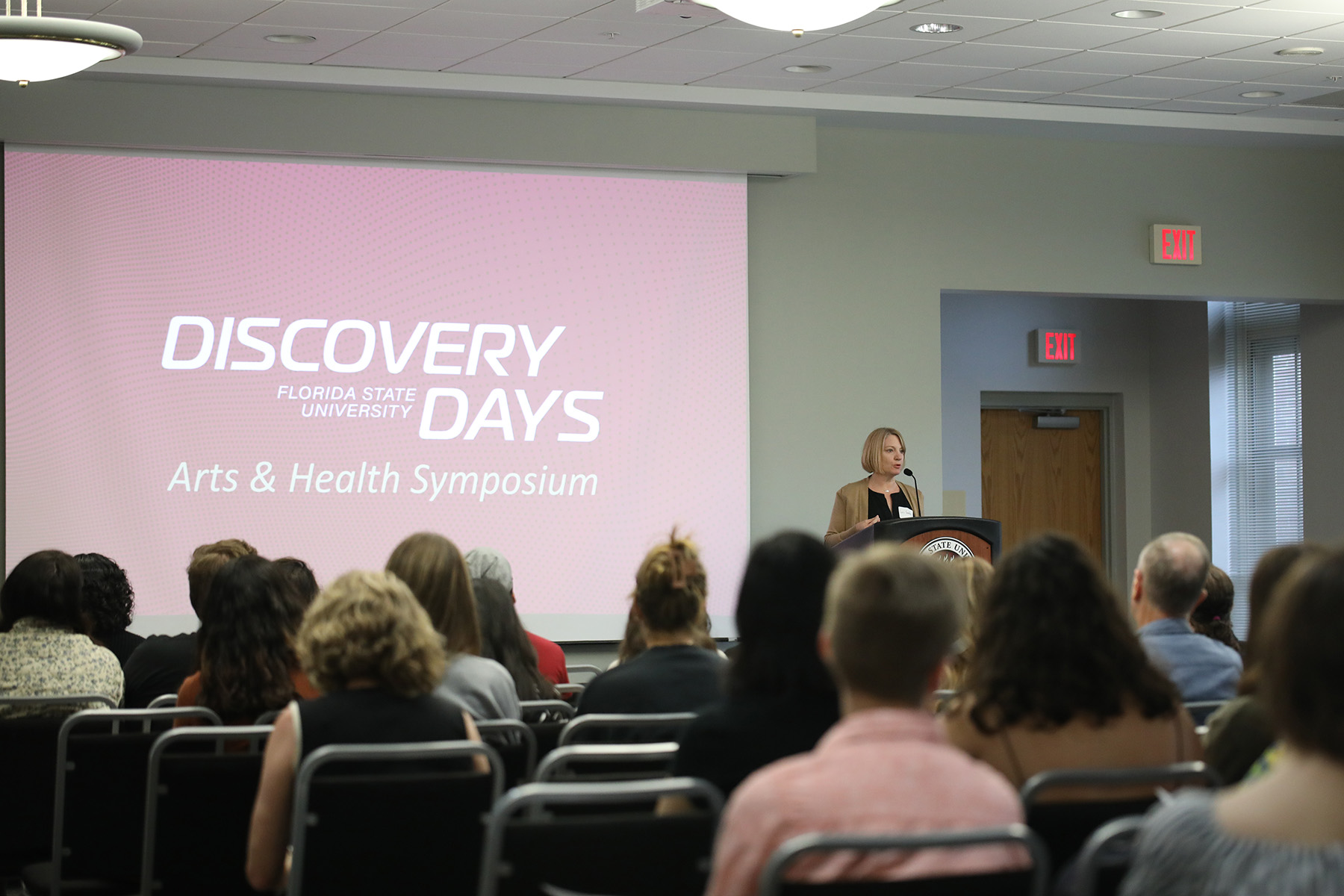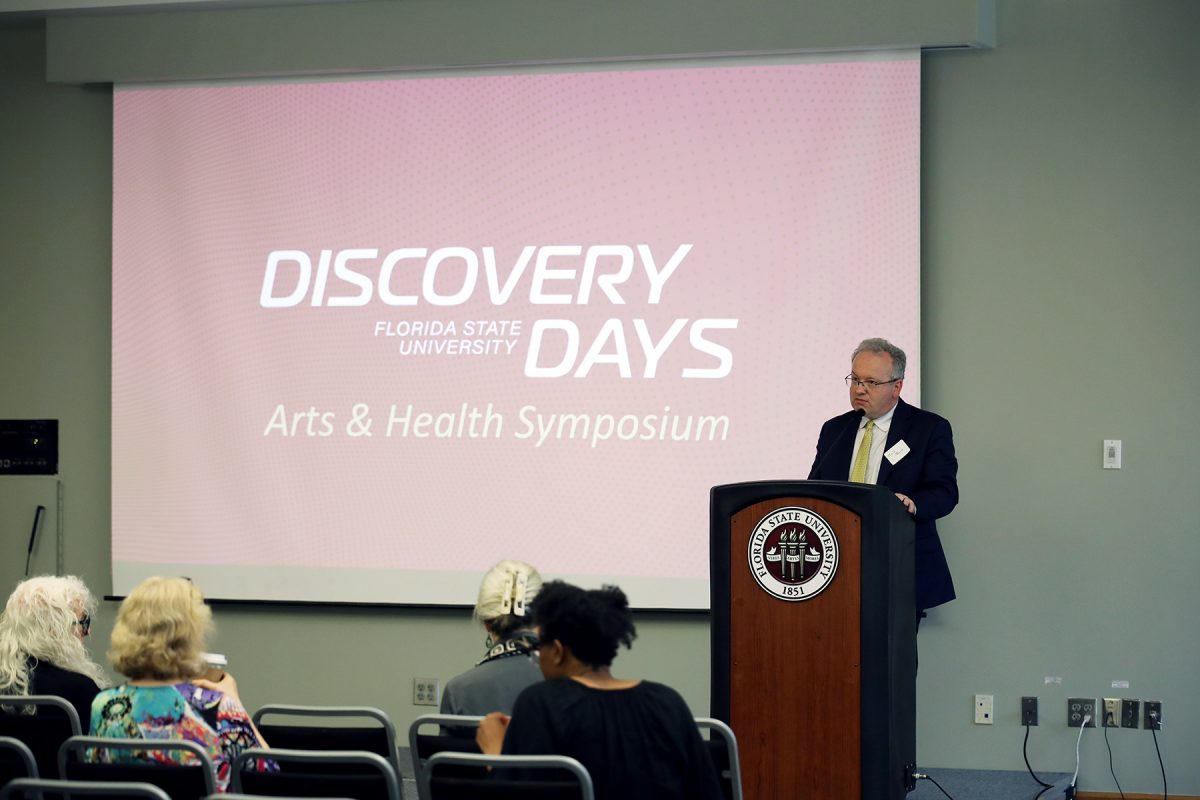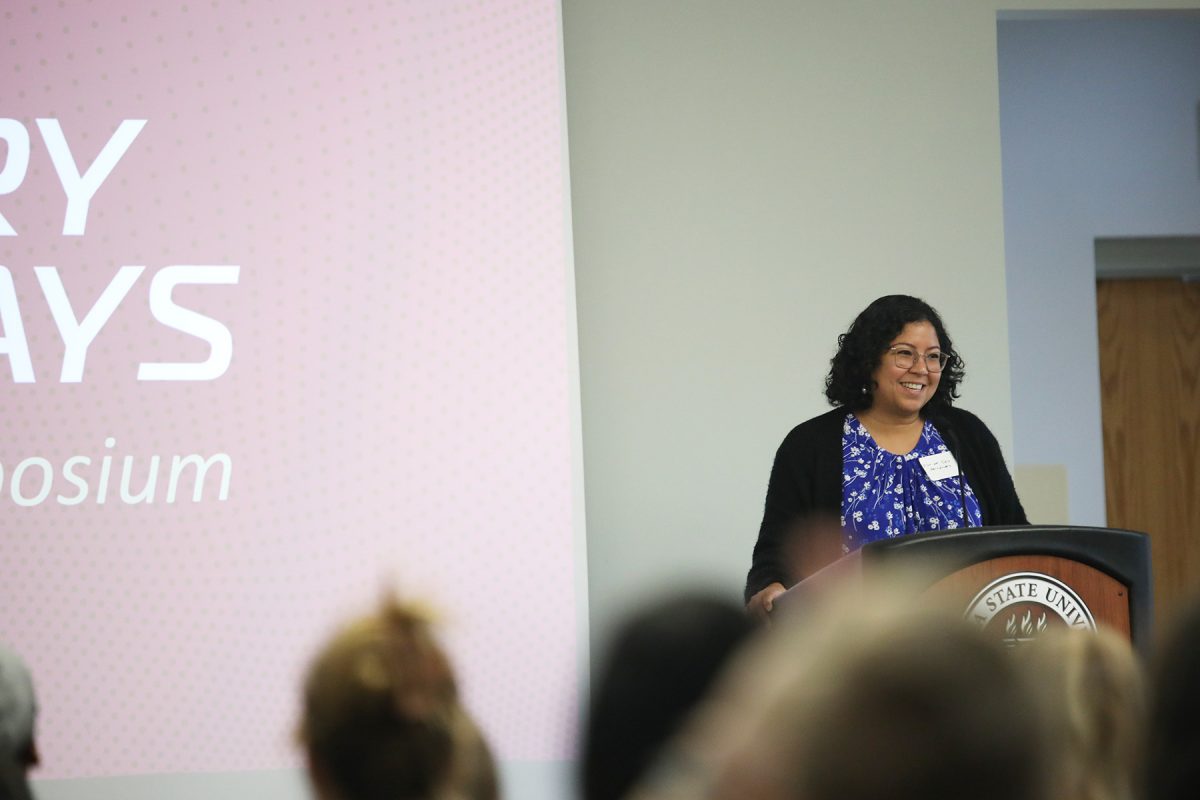
Florida State University researchers whose work focuses on the intersection of arts and health are working together to see how they can better promote the arts in holistic health care settings and better collaborate to further research in this area.
The researchers met as part of the Arts and Health Symposium during FSU Discovery Days, a week that celebrates FSU research, creativity and innovation.
Professor of Organ Iain Quinn, who serves as the university’s Research Fellow in the Arts and Humanities, emphasized the importance of bringing together faculty who may not normally meet.
“We work in an increasingly interdisciplinary environment and for that to work successfully and be sustained, each party must feel free to contribute their research with minimal compromises,” Quinn said. “This symposium is not about encouraging interdisciplinary collaborations that you’re not really interested in, but rather the possible collaborations that would strengthen research and creativity.”
Each presentation outlined the premise of each faculty member’s research, followed by a roundtable discussion.
The following faculty presented at the symposium:
Nicholas F. Mazza, dean emeritus of the College of Social Work, presented his research “Poetry Therapy: The Interface of Literary and Therapeutic Perspectives in Advancing Health and Well-Being.” Through poetry therapy, Mazza hopes to integrate literary and therapeutic perspectives with language and story.
“Using my experience and collaboration, I developed a model of poetry therapy that highlights the receptive, the expressive and the resting symbolic to effectively integrate poetry as a means of healing,” Mazza said.
Jill Pable, professor of interior architecture and design, introduced “Project Lead: Design Resources for Homelessness” a trauma-informed design study to assist unhoused persons and help them exit their crisis.
Pable’s research focuses on ways that places can assist people who have lost their homes or are otherwise experiencing trauma.
“Buildings can be designed to promote a sense of community to let people see each other, to provide roundtables that create an equitable place to gather in,” Pable said. “My research focuses on how interior design can use trauma-informed design to create spaces that promote dignity and self-esteem.”
Dawn Iwamasa, assistant professor of music therapy, discussed the current neurobiological theory behind music for pain management and the importance of collaborating with medical professionals.
“Pain management is a big topic right now because of the use of opioids and the medical setting seeking nonpharmacological methods of pain management,” Iwamasa said. “As music therapists, we rely on that partnership with the medical professionals to tell us what the needs of the patients are.”
Lori F. Gooding, associate professor of music therapy and music education, continued the symposium with her presentation of the various interdisciplinary research projects that advocate for music therapy’s role in integrative health care.
Gooding highlighted the collaboration developing between the College of Music and College of Medicine to pair transcranial magnetic stimulation, or TMS, with music to study its impact on mood in patients with conditions like depression and PTSD.
“Creating these partnerships allows us to think differently about some of the existing problems in the health care system and to engage the patients and the participants in ways that they may not engage otherwise,” Gooding said.
Assistant Professor of Music Therapy Flor del Cielo Hernandez discussed her initiative to close the gap between “crisis” and “long-term” mental health care in Tallahassee by introducing music therapy to neurodivergent children.
“I am big into active music making because making music with other people is just joyful,” Hernandez said. “It’s highly motivating, but also frustrating at the same time, which gives us space in a safe and controlled environment to talk about how to do emotional regulation and express ourselves without getting in trouble.”
Barbara Parker-Bell, professor and director of art therapy programs, presented “Design Your Career Guide.” Created with Professor Deb Osborn with support from a 2021-2022 FSU Collaborative Collision Research Seed Fund Award and student research team members, the guide supports middle and high school students from underserved communities and teaches them to develop self-knowledge and decision-making skills to promote career development.
“The guide represents the results of interdisciplinary collaborative efforts combining Cognitive Information Processing Theory and art therapy approaches to support career development,” Parker-Bell said. “We are excited to cultivate these essential career development skills as they significantly influence individuals’ long-term career, economic and health outcomes.”
Nancy Gerber, specialized teaching faculty in the Department of Art Education, continued the conversation regarding art therapy and its effectiveness. Gerber shared her project “Sustaining Life on Earth: Arts-Based Responses to COVID-19,” a three-part video and gallery exploring the different emotional phases of the COVID-19 pandemic.
“Through our project, we captured an experience that is otherwise indescribable, the experience of the pandemic,” Gerber said. “The arts reach beyond the physical, visible, obvious and measurable to reveal an X-ray of the soul — the thoughts, emotions and sensations that accompany health conditions but are unutterable.”
TaNica Holmes, art therapy master’s candidate, delved into the study “Daddies Cry Too: A Cumulative Collage Process to Explore Fathers’ Lived Experiences of Paternal Postpartum Depression: Phenomenological Arts-Informed Study.” The research explores fathers’ lived experiences and will use an art based visual and oral interview to support fathers with postpartum depression.
“One out of 10 fathers are diagnosed with postpartum depression, but that’s just the number of diagnoses,” Holmes said. “A lot of men do not know that they have this or know how to express it, so I’m exploring this to bring this issue to light.”
David Gussak, professor of art therapy, discussed the effectiveness of art therapy for prison inmates. Through an IDEA grant and partnership with FSU art therapy, the Florida Department of Corrections created the FSU/FDC Art Therapy in Prisons Program, which provides service to nine prisons throughout Florida.
It has seen success in facilitating changes in its institutions’ male and female youthful offender populations.
“Art therapy has improved prison inmates’ ability to regulate control, promote anger management and mitigate neurological struggles, substance abuse and intellectual challenges,” Gussak said. “As such, art therapy mitigates obstacles to obtaining an education while reinforcing resilience and opportunities for inclusion back into society upon release.”






